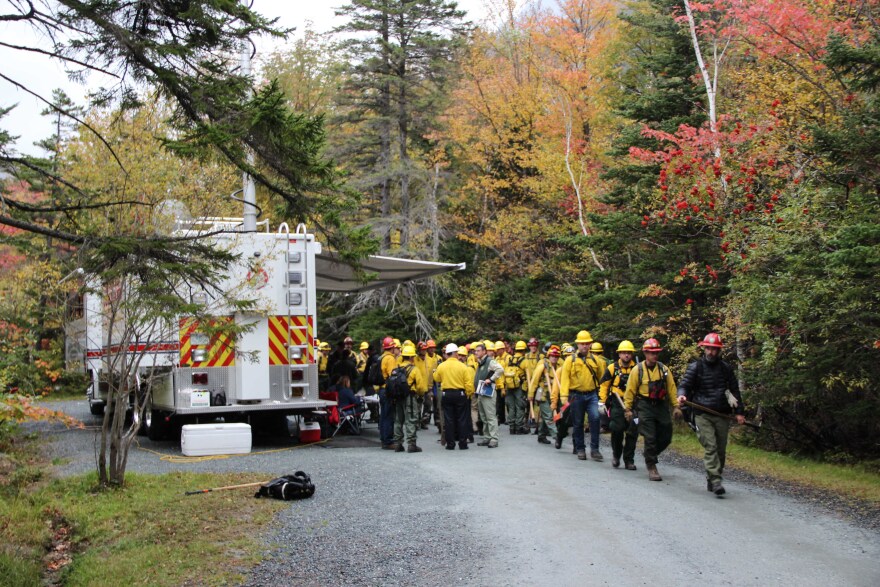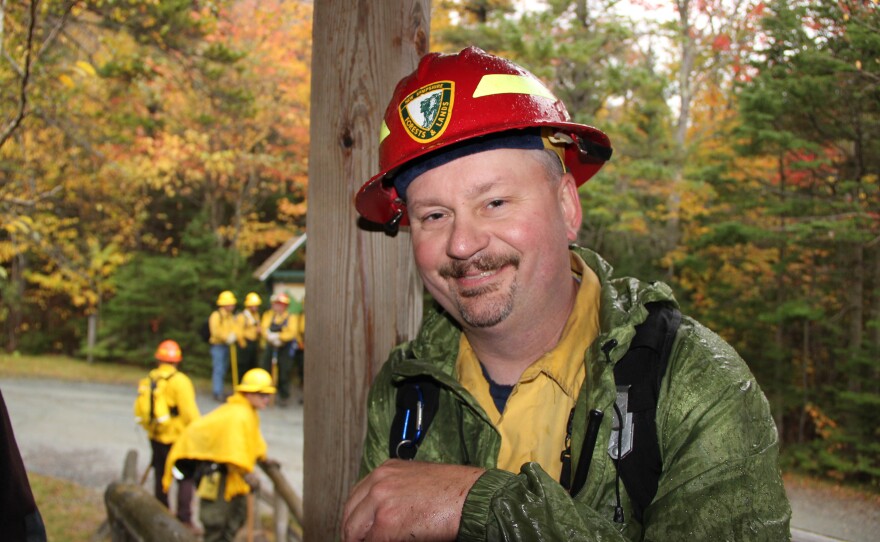[WEEKEND Update: Firefighters reported good progress Saturday, with wet weather helping crews. Route 112 near Kinsman Notch is open. The U.S. Forest Service warns motorists to look out for fire vehicle traffic. Read and listen below to Sean Hurley's report Friday night.]
THOUGH MORNING RAIN has dampened the wildfire in North Woodstock, there are still more than 80 firefighters trying to contain the 70-acre blaze. As NHPR’s Sean Hurley reports, officials still aren’t sure what caused the fire – or when they’ll be able to put it out.
Fire Patrolman Wayne Howe removes a glove, extends a hand, looks up - and smiles. A light rain has just begun. “We've got to take advantage of the rain situation,” Howe says, “it's gonna help immensely.”

Howe and the 19 other firefighters in his crew stand together in the Lost River Gorge parking lot waiting for the call to head up into the smoke of the Dilly Cliffs Trail. “Very steep and hilly and a lot of snags, falling trees,” he says. “So you gotta be very careful. You gotta work slow and methodical.”
And hard. Howe and the members of Crew One look more like loggers – with chainsaws, shovels and axes. Their work, he says, involves “a lot of swinging, a lot of digging. We have to make what's called a fire line. We've got to remove any vegetation that can burn down to mineral soil.”
Tyler Clark, a Captain at the Woodstock Fire Department, has been fighting the fire from the start. “Since 6 a.m. the day it started,” Clark says. “We were the first crew in. When we got up there we had to actually search for the fire. We could smell the smoke but we couldn't find any fire, couldn't see anything else - we had to get off the trail and head in probably 100 yards until we finally found fire and it was only at that time maybe 80 yards wide from the base of the cliff down. But yeah it was a lot different and then that day it drastically changed.”
Clark has watched the fire expand daily. “You know the fire has been growing and growing,” he says, “but some days you go in there and it's like ‘oh wow, our line held all night long.’ And then it takes one flame to hop it and the next thing you know we're making new lines around. So you just keep chasing it. So the fire keeps going across the line and we make a new line further - cross the line and just keep chasing it like that.”
Crew Boss Dave Kullgren steps out of the Command Center and the crew lines up at the trailhead. “Squad two and then squad 3 fall in!” Kullgren calls to his crew.”Ready to go? Moving.”
Dave Walker watches them go. This is his first day in charge here. “We took the operations today,” Walker says, “once the local units determined that the complexity had increased due to the size and magnitude of the fire.”
The Dilly Fire, he tells me, has been upgraded to a Type 3 wildfire from a type 4. Unlike hurricanes, he says, the numbering system for wildfires counts down to 1 as intensity and instability increase. “We haven't established any percentage of containment at this point in time,” Walker says, “but we are starting to get a handle on the fire which has grown from 20 some odd acres initially at the end of the first day to approximately 70 plus acres today.”

Walker says the difficult terrain, occasional high winds and uncertain weather, make predicting containment tricky. “Our assessment is that we are probably looking at having to deal with this incident over the next week to two weeks,” he says.
Crew Boss Dave Kullgren emerges, unexpectedly, from the Dilly Cliffs Trail, the 19 members of Crew One following behind him. “They're pulling us off the hill,” he tells me. “Radar shows heavy rain coming.”
Kullgren gathers Crew One together. “So go back to your vehicles, warm up,” he tells them. “Again, most of you guys have been there the last few days know how unsafe it is. Slippery, mossy, wet rocks don't mix. So alright guys, hunker down, thanks.”
As Woodstock Fire Captain Tyler Clark and Fire Patrolman Wayne Howe head off to their trucks to wait, Dave Kullgren says it might be a while before the Dilly Fire is out. “We don't know,” Kullgren says. “Like days, weeks. You know. It will be a while.”








